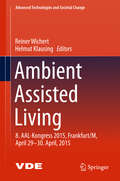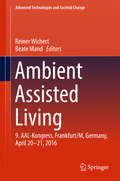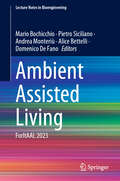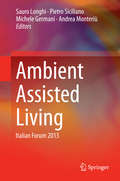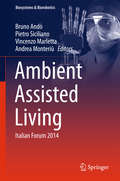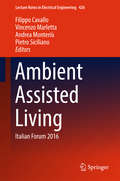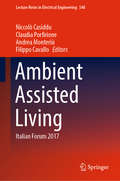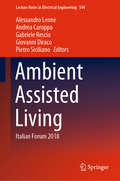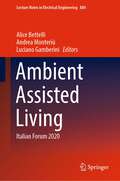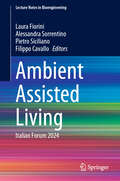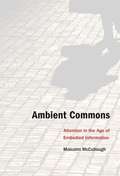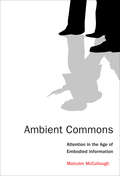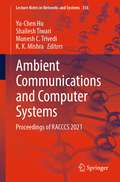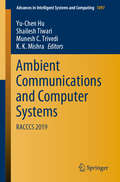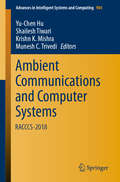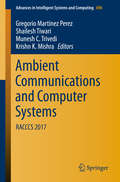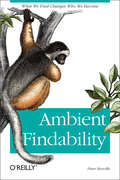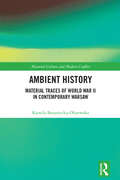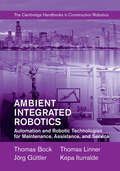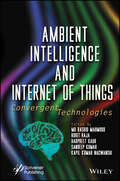- Table View
- List View
Ambient Assisted Living: 6. AAL-Kongress 2013 Berlin, Germany, January 22. - 23. , 2013 (Advanced Technologies and Societal Change)
by Reiner Wichert Helmut KlausingIn this book, leading authors in the field discuss developments of Ambient Assisted Living. The contributions have been chosen and invited at the 8th AAL Congress, Frankfurt/M. The meeting presents new technological developments which support the autonomy and independence of individuals with special needs. The 8th AAL Congress focusses its attention on technical assistance systems and their applications in homecare, health and care.
Ambient Assisted Living: 8. AAL-Kongress 2015,Frankfurt/M, April 29-30. April, 2015 (Advanced Technologies and Societal Change)
by Reiner Wichert Helmut KlausingIn this book, leading authors in the field discuss developments of Ambient Assisted Living. The contributions have been chosen and invited at the 8th AAL Congress, Frankfurt/M. The meeting presents new technological developments which support the autonomy and independence of individuals with special needs. The 8th AAL Congress focusses its attention on technical assistance systems and their applications in homecare, health and care.
Ambient Assisted Living: 9. AAL-Kongress, Frankfurt/M, Germany, April 20 - 21, 2016 (Advanced Technologies and Societal Change)
by Reiner Wichert Beate MandIn this book, 22 authors discuss development of Ambient Assisted Living. It presents new technological developments which support the autonomy and independence of individuals with special needs. As the technological innovation raises also social issues, the book addresses micro and macro economical aspects of assistive systems and puts an additional emphasis on the ethical and legal discussion. The presentation is supported by real world examples and applications.
Ambient Assisted Living: ForItAAL 2023 (Lecture Notes in Bioengineering)
by Pietro Siciliano Andrea Monteriù Alice Bettelli Mario Bochicchio Domenico De FanoThis book provides state-of-the-art information on ambient assisted living (AAL), and focuses on technologies, services, living spaces, policies, and interventions to promote health, improve quality of life, and active aging. It includes various research contributions, case studies, and projects where assistive technologies are successfully applied in the field, and it covers a wide range of topics: Tailoring products and services to the Aging society, Bio-data and Artificial sensing AAL scenarios, Cognition, and Technologies, and Designing for Inclusion and Well-Being. The volume gathers the refereed proceedings of the 12th Italian Forum on Ambient Assisted Living (ForItAAL), held in Bari, Italy on June 14-16, 2023. With its wide-ranging contributions to the topic, the book will inspire the readers and the researchers to continue their exploration of AAL technologies to support the development of products and services that make a real difference in people’s daily lives.
Ambient Assisted Living: Italian Forum 2013 (Lecture Notes in Electrical Engineering #11)
by Sauro Longhi Pietro Siciliano Michele Germani Andrea MonteriùThis book presents the refereed proceedings of the Fourth Italian Forum on Ambient Assisted Living (AAL), held in Ancona, Italy, in October 2013. A wide range of issues are covered and new technological developments are described which will support the autonomy and independence of individuals with special needs through an innovative and integrated approach, designed to respond to the socio-economic challenges of an aging population. Topics addressed include: health and well-being, prevention and rehabilitation and support for care providers; active aging and its social implications; services for the frail elderly with health problems and their families; nutrition; ICT platforms/technologies for the benefit of the elderly; home automation and control technologies (autonomy, safety and energy saving); smart cities and smart communities; telemedicine, telerehabilitation, and telecare; mobility, participation and social inclusion; games and fun for the elderly; building design; social housing; interface design and interaction (accessibility, acceptance); social policies to encourage and support active aging; business models, market analysis and development of sustainable financing and business and ethics, privacy and data protection. Many experimental validations based on user trials and usability testing are presented and discussed. The knowledge and insights provided in this book will help researchers and others involved in AAL to understand relevant societal trends, novel technological developments and pressing challenges.
Ambient Assisted Living: Italian Forum 2014 (Biosystems & Biorobotics #11)
by Pietro Siciliano Andrea Monteriù Bruno Andò Vincenzo MarlettaThis book documents the state of the art in the field of ambient assisted living (AAL), highlighting the impressive potential of novel methodologies and technologies to enhance well-being and promote active ageing. The coverage is wide ranging, with sections on assistive devices, elderly people monitoring, home rehabilitation, ICT solutions for AAL, living with chronic conditions, robotic assistance for the elderly, sensing technologies for AAL, and smart housing. The book comprises a selection of the best papers presented at the Fifth Italian Forum on Ambient Assisted Living, which was held in Catania, Italy, in September 2014 and brought together end users, technology teams, and policy makers to develop a consensus on how to improve provision for elderly and impaired people. Readers will find that the expert contributions offer clear insights into the ways in which the most recent exciting advances may be expected to assist in addressing the needs of the elderly and those with chronic conditions.
Ambient Assisted Living: Italian Forum 2016 (Lecture Notes in Electrical Engineering #426)
by Pietro Siciliano Andrea Monteriù Vincenzo Marletta Filippo CavalloThis book presents the refereed proceedings of the Fourth Italian Forum on Ambient Assisted Living (AAL), held in Ancona, Italy, in October 2013. A wide range of issues are covered and new technological developments are described which will support the autonomy and independence of individuals with special needs through an innovative and integrated approach, designed to respond to the socio-economic challenges of an aging population. Topics addressed include: health and well-being, prevention and rehabilitation and support for care providers; active aging and its social implications; services for the frail elderly with health problems and their families; nutrition; ICT platforms/technologies for the benefit of the elderly; home automation and control technologies (autonomy, safety and energy saving); smart cities and smart communities; telemedicine, telerehabilitation, and telecare; mobility, participation and social inclusion; games and fun for the elderly; building design; social housing; interface design and interaction (accessibility, acceptance); social policies to encourage and support active aging; business models, market analysis and development of sustainable financing and business and ethics, privacy and data protection. Many experimental validations based on user trials and usability testing are presented and discussed. The knowledge and insights provided in this book will help researchers and others involved in AAL to understand relevant societal trends, novel technological developments and pressing challenges.
Ambient Assisted Living: Italian Forum 2017 (Lecture Notes in Electrical Engineering #540)
by Andrea Monteriù Filippo Cavallo Niccolò Casiddu Claudia PorfirioneThis book documents the state of the art in the field of ambient assisted living (AAL), highlighting the impressive potential of novel methodologies and technologies to enhance well-being and promote active ageing. It covers a broad range of topics, with sections on technological sensors and platforms, social robotics for assistance, assistance and care applications, health and medical support methodologies and technologies, as well as the analysis, modelling and design of AAL services. <P><P> The book comprises a selection of the best papers presented at the 8th Italian Forum on Ambient Assisted Living (ForitAAL 2017), which was held in Genoa, Italy, in June 2017 and brought together researchers, technology teams and professional associations, as well as representatives of the Italian regions and advisors to the Italian Ministry of Education, University and Research, with the goal of developing a consensus on how to improve provisions for the elderly and impaired. The respective contributions offer valuable insights into how the latest advances can help address the needs of the elderly and those with chronic health conditions. They also underscore the need for AAL to continue moving toward multidisciplinary integration, so as to embrace the various disciplines that place the user of services at the centre of the design process.
Ambient Assisted Living: Italian Forum 2018 (Lecture Notes in Electrical Engineering #544)
by Pietro Siciliano Alessandro Leone Andrea Caroppo Gabriele Rescio Giovanni DiracoThis book documents the state of the art in the field of ambient assisted living (AAL), highlighting the impressive potential of novel methodologies and technologies to enhance well-being and promote active ageing. The coverage is wide ranging, with sections on care models and algorithms, enabling technologies and assistive solutions, elderly people monitoring, home rehabilitation, ICT solutions for AAL, living with chronic conditions, robotic assistance for the elderly, sensing technologies for AAL, and smart housing. The book comprises a selection of the best papers presented at the 9th Italian Forum on Ambient Assisted Living (ForitAAL 2018), which was held in Lecce, Italy, in July 2018 and brought together end users, technology teams, and policy makers to develop a consensus on how to improve provision for elderly and impaired people. Readers will find that the expert contributions offer clear insights into the ways in which the most recent exciting advances may be expected to assist in addressing the needs of the elderly and those with chronic conditions.
Ambient Assisted Living: Italian Forum 2019 (Lecture Notes in Electrical Engineering #725)
by Sauro Longhi Andrea Monteriù Alessandro FreddiThis book documents the state of the art in the field of ambient assisted living (AAL), highlighting technologies and services which aim to improve health and quality of life, while promoting active aging. The coverage is wide ranging, with topical sections devoted to human monitoring, smart living services, biomedical and robotic solutions, including different case studies and real-world examples where assistive technologies are successfully applied. The book comprises a selection of the best, refereed papers presented at the 10th Italian Forum on Ambient Assisted Living (ForItAAL), held in Ancona, Italy, in June 2019, which represents the annual event that involves the Ambient Assisted Living Italian Association and brought together researchers, technology teams, policy makers, and stake-holders. Readers will find that the expert contributions offer clear insights into the ways in which the most recent exciting advances may be expected to assist in addressing the needs of the elderly and those with chronic conditions.
Ambient Assisted Living: Italian Forum 2020 (Lecture Notes in Electrical Engineering #884)
by Luciano Gamberini Andrea Monteriù Alice BettelliThis book provides state-of-the-art information on ambient assisted living (AAL), and focuses on technologies, services, living spaces, policies, and interventions to promote health, improve quality of life, and active aging. It includes various research contributions, case studies, and projects where assistive technologies are successfully applied in the field, and it covers a wide range of topics: Tailoring products and services to the Aging society, Bio-data and Artificial sensing AAL scenarios, Cognition, and Technologies, and Designing for Inclusion and Well-Being. The volume gathers the refereed proceedings of the 11th Italian Forum on Ambient Assisted Living (AAL), ForItAAL2020. This annual event involves companies, researchers, and stakeholders involved in the field of Ambient Assisted Living, it took place online due to the pandemic situation of Covid-19, and was organized by the University of Padua through the Human Inspired Technologies Research Centre and the Regional Innovative Network “ICT for Smart and Sustainable Living” with the contribution of the Smart Living Technologies’ Cluster. With its wide-ranging contributions to the topic, the book will inspire the readers and the researchers to continue their exploration of AAL technologies to support the development of products and services that make a real difference in people’s daily lives.
Ambient Assisted Living: Italian Forum 2024 (Lecture Notes in Bioengineering)
by Pietro Siciliano Filippo Cavallo Laura Fiorini Alessandra SorrentinoThis book provides state-of-the-art information on ambient assisted living (AAL) and focuses on technologies, services, living spaces, policies, and interventions to promote health, improve quality of life, and active aging. It includes various research contributions, case studies, and projects where assistive technologies are successfully applied in the field, and it covers a wide range of topics: tailoring products and services to the aging society, bio-data and artificial sensing AAL scenarios, cognition, and technologies, and designing for inclusion and well-being. The book gathers the refereed proceedings of the 13th Italian Forum on Ambient Assisted Living (ForItAAL), held in Florence, Italy, on June 25–28, 2024. With its wide-ranging contributions to the topic, the book inspires the readers and the researchers to continue their exploration of AAL technologies to support the development of products and services that make a real difference in people’s daily lives.
Ambient Assisted Living: Transitioning from Healthcare 4.0 to Healthcare 5.0 (Innovations in Health Informatics and Healthcare)
by Lalit Mohan Goyal Rashmi Gupta Blanco Valencia, Xiomara Patricia Jeetendra KumarAmbient assisted living (AAL) utilizes information and communication technology to empower individuals to maintain an active and independent lifestyle for as long as possible. The concept of AAL has been around for decades, but with the evolution of the healthcare sector, we have seen significant advancements in AAL technologies. In recent years, there has been a growing trend towards living alone, and AAL plays a crucial role in supporting individuals to live independently. Ambient Assisted Living (AAL) Technologies: Transitioning from Healthcare 4.0 to Healthcare 5.0 is divided into four comprehensive sections that explore the shift from Healthcare 4.0 to Healthcare 5.0. It covers AAL technology in the context of Healthcare 4.0 and the Internet of Things (IoT) and fog computing frameworks for real-time applications of natural language processing (NLP) in AAL. The text also delves into advanced artificial intelligence methods for data analytics in AAL, focusing on real-time applications and data analysis for practical use. Additionally, the book covers advanced enabling technologies like blockchain, big data, fog computing and cutting-edge AI techniques for assisted living in Healthcare 5.0. The integration of these technologies and perspectives is crucial for advancing assisted living in the realm of Healthcare 5.0. This book is perfect for students and researchers specializing in AAL and NLP. Professionals working on products for assisted living can also benefit from the valuable insights provided by recent research to improve the efficiency and advancement of their products. The topic of AAL is already a part of the curriculum in many universities and institutes, and this book will help students explore the various applications of NLP within this field. In addition, individuals looking to engage in innovative projects can find inspiration from the latest advancements in AAL.
Ambient Commons
by Malcolm McculloughThe world is filling with ever more kinds of media, in ever more contexts andformats. Glowing rectangles have become part of the scene; screens, large and small, appeareverywhere. Physical locations are increasingly tagged and digitally augmented. Sensors, processors,and memory are not found only in chic smart phones but also built into everyday objects. Amid thisflood, your attention practices matter more than ever. You might not be able to tune this world out. So it is worth remembering that underneath all these augmentations and data flows, fixed formspersist, and that to notice them can improve other sensibilities. In AmbientCommons, Malcolm McCullough explores the workings of attention though a rediscovery ofsurroundings. Not all that informs has been written and sent; not all attention involves deliberatethought. The intrinsic structure of space -- the layout of a studio, for example, or a plaza --becomes part of any mental engagement with it. McCullough describes what he calls the Ambient: anincreasing tendency to perceive information superabundance whole, where individual signals matterless and at least some mediation assumes inhabitable form. He explores how the fixed forms ofarchitecture and the city play a cognitive role in the flow of ambient information. As apersistently inhabited world, can the Ambient be understood as a shared cultural resource, to besocially curated, voluntarily limited, and self-governed as if a commons? AmbientCommons invites you to look past current obsessions with smart phones to rethink attentionitself, to care for more situated, often inescapable forms of information.
Ambient Commons: Attention in the Age of Embodied Information (The\mit Press Ser.)
by Malcolm McCulloughOn rediscovering surroundings when information goes everywhere.The world is filling with ever more kinds of media, in ever more contexts and formats. Glowing rectangles have become part of the scene; screens, large and small, appear everywhere. Physical locations are increasingly tagged and digitally augmented. Amid this flood, your attention practices matter more than ever. You might not be able to tune this world out. So it is worth remembering that underneath all these augmentations and data flows, fixed forms persist, and that to notice them can improve other sensibilities. In Ambient Commons, Malcolm McCullough explores the workings of attention through a rediscovery of surroundings.McCullough describes what he calls the Ambient: an increasing tendency to perceive information superabundance whole, where individual signals matter less and at least some mediation assumes inhabitable form. He explores how the fixed forms of architecture and the city play a cognitive role in the flow of ambient information. As a persistently inhabited world, can the Ambient be understood as a shared cultural resource, to be socially curated, voluntarily limited, and self-governed as if a commons? Ambient Commons invites you to look past current obsessions with smart phones to rethink attention itself, to care for more situated, often inescapable forms of information.
Ambient Communications and Computer Systems: Proceedings of RACCCS 2021 (Lecture Notes in Networks and Systems #356)
by Yu-Chen Hu Shailesh Tiwari Munesh C. Trivedi K. K. MishraThis book features high-quality, peer-reviewed papers from the Fourth International Conference on Recent Advancements in Computer, Communication, and Computational Sciences (RACCCS 2021), held at Aryabhatta College of Engineering and Research Center, Ajmer, India, on August 20–21, 2021. Presenting the latest developments and technical solutions in computational sciences, it covers a variety of topics, such as intelligent hardware and software design, advanced communications, intelligent computing technologies, advanced software engineering, the web and informatics, and intelligent image processing. As such, it helps those in the computer industry and academia to use the advances in next-generation communication and computational technology to shape real-world applications.
Ambient Communications and Computer Systems: RACCCS 2019 (Advances in Intelligent Systems and Computing #1097)
by Yu-Chen Hu Shailesh Tiwari Munesh C. Trivedi K. K. MishraThis book features high-quality, peer-reviewed papers from the International Conference on Recent Advancement in Computer, Communication and Computational Sciences (RACCCS 2019), held at Aryabhatta College of Engineering & Research Center, Ajmer, India, on August 16–17, 2019. Presenting the latest developments and technical solutions in computational sciences, it covers a variety of topics, such as intelligent hardware and software design, advanced communications, intelligent computing technologies, advanced software engineering, the web and informatics, and intelligent image processing. As such it helps those in the computer industry and academia to use the advances in next-generation communication and computational technology to shape real-world applications.
Ambient Communications and Computer Systems: RACCCS-2018 (Advances in Intelligent Systems and Computing #904)
by Yu-Chen Hu Krishn K. Mishra Shailesh Tiwari Munesh C. TrivediThis book includes high-quality, peer-reviewed papers from the International Conference on Recent Advancement in Computer, Communication and Computational Sciences (RACCCS-2018), held at Aryabhatta College of Engineering & Research Center, Ajmer, India on August 10–11, 2018, presenting the latest developments and technical solutions in computational sciences. Networking and communication are the backbone of data science, data- and knowledge engineering, which have a wide scope for implementation in engineering sciences. This book offers insights that reflect the advances in these fields from upcoming researchers and leading academicians across the globe. Covering a variety of topics, such as intelligent hardware and software design, advanced communications, intelligent computing technologies, advanced software engineering, the web and informatics, and intelligent image processing, it helps those in the computer industry and academia use the advances in next-generation communication and computational technology to shape real-world applications.
Ambient Communications and Computer Systems: Racccs 2017 (Advances In Intelligent Systems And Computing #696)
by Gregorio Martinez Perez Krishn K. Mishra Shailesh Tiwari Munesh C. TrivediThis book includes high-quality, peer-reviewed papers from the International Conference on Recent Advancement in Computer, Communication and Computational Sciences (RACCCS-2017), held at Aryabhatta College of Engineering & Research Center, Ajmer, India on September 2–3, 2017, presenting the latest developments and technical solutions in computational sciences. <p><p> Data science, data- and knowledge engineering require networking and communication as a backbone and have a wide scope of implementation in engineering sciences. Keeping this ideology in mind, the book offers insights that reflect the advances in these fields from upcoming researchers and leading academicians across the globe. Covering a variety of topics, such as intelligent hardware and software design, advanced communications, intelligent computing technologies, advanced software engineering, the web and informatics, and intelligent image processing, it helps those in the computer industry and academia use the advances of next-generation communication and computational technology to shape real-world applications.
Ambient Diagnostics
by Yang CaiAmbient Diagnostics addresses innovative methods for discovering patterns from affordable devices, such as mobile phones, watches, cameras, and game interfaces, to interpret multimedia data for personal health monitoring and diagnosis. This is the first comprehensive textbook on multidisciplinary innovations in affordable healthcare-from senso
Ambient Findability: What We Find Changes Who We Become
by Peter MorvilleHow do you find your way in an age of information overload? How can you filter streams of complex information to pull out only what you want? Why does it matter how information is structured when Google seems to magically bring up the right answer to your questions? What does it mean to be "findable" in this day and age? This eye-opening new book examines the convergence of information and connectivity. Written by Peter Morville, author of the groundbreaking Information Architecture for the World Wide Web, the book defines our current age as a state of unlimited findability. In other words, anyone can find anything at any time. Complete navigability.Morville discusses the Internet, GIS, and other network technologies that are coming together to make unlimited findability possible. He explores how the melding of these innovations impacts society, since Web access is now a standard requirement for successful people and businesses. But before he does that, Morville looks back at the history of wayfinding and human evolution, suggesting that our fear of being lost has driven us to create maps, charts, and now, the mobile Internet.The book's central thesis is that information literacy, information architecture, and usability are all critical components of this new world order. Hand in hand with that is the contention that only by planning and designing the best possible software, devices, and Internet, will we be able to maintain this connectivity in the future. Morville's book is highlighted with full color illustrations and rich examples that bring his prose to life.Ambient Findability doesn't preach or pretend to know all the answers. Instead, it presents research, stories, and examples in support of its novel ideas. Are we truly at a critical point in our evolution where the quality of our digital networks will dictate how we behave as a species? Is findability indeed the primary key to a successful global marketplace in the 21st century and beyond. Peter Morville takes you on a thought-provoking tour of these memes and more -- ideas that will not only fascinate but will stir your creativity in practical ways that you can apply to your work immediately."A lively, enjoyable and informative tour of a topic that's only going to become more important."--David Weinberger, Author, Small Pieces Loosely Joined and The Cluetrain Manifesto"I envy the young scholar who finds this inventive book, by whatever strange means are necessary. The future isn't just unwritten--it's unsearched."--Bruce Sterling, Writer, Futurist, and Co-Founder, The Electronic Frontier Foundation"Search engine marketing is the hottest thing in Internet business, and deservedly so. Ambient Findability puts SEM into a broader context and provides deeper insights into human behavior. This book will help you grow your online business in a world where being found is not at all certain."--Jakob Nielsen, Ph.D., Author, Designing Web Usability: The Practice of Simplicity"Information that's hard to find will remain information that's hardly found--from one of the fathers of the discipline of information architecture, and one of its most experienced practitioners, come penetrating observations on why findability is elusive and how the act of seeking changes us."--Steve Papa, Founder and Chairman, Endeca"Whether it's a fact or a figure, a person or a place, Peter Morville knows how to make it findable. Morville explores the possibilities of a world where everything can always be found--and the challenges in getting there--in this wide-ranging, thought-provoking book."--Jesse James Garrett, Author, The Elements of User Experience"It is easy to assume that current searching of the World Wide Web is the last word in finding and using information. Peter Morville shows us that search engines are just the beginning. Skillfully weaving together information science research with his own extensive experie
Ambient History: Material Traces of World War II in Contemporary Warsaw (Material Culture and Modern Conflict)
by Kamila Baraniecka-OlszewskaAmbient History presents the role urban fabric plays in constructing the wartime history of Warsaw. It focuses on history embedded in matter and details the practices followed by municipal institutions, artists and historical reenactors who pull history out of the background through their actions.The book offers a new perspective on the material history of the city. It presents the concept of ambient history – history hidden in the background, in the landscape – waiting to be utilised by individuals coming into contact with the fabric of the city. It draws on anthropological considerations of history which embrace non-academic methods of conceptualising the past and processes of democratising history. The book has two principal objectives. One is to give theoretical grounding to the term ‘ambient history’, which facilitates the conceptualisation of material history and the role experiencing it plays in the process of constructing history. The other is to try and determine the limits of the heuristic potential of posthumanist reflection on materiality in reference to research focused on the making of history.Therefore, the book is valuable reading for researchers studying non-academic methods of curating history: scholars investigating materiality and things, anthropologists of history, scholars of heritage studies, experts in urban studies, historians focused on public history and archaeologists analysing the discipline’s theory.
Ambient Integrated Robotics: Automation and Robotic Technologies for Maintenance, Assistance, and Service
by Thomas Bock Thomas Linner Jörg Güttler Kepa IturraldeThe new research field of Ambient/Active Assisted Living (AAL) is quickly evolving. Ambient Integrated Robotics provides an easy-to-understand medical perspective to architects, designers, and engineers, bridging the different disciplines and showing how they fuse together to create the future of AAL technology. Using robotics as an example, the book illustrates how embedding its subsystems results in unique ambient technology that can be used to help people, particularly in adapting to the needs of the unwell and elderly populations. You will be provided with the knowledge and tools to contribute to the future of AAL. The Cambridge Handbooks on Construction Robotics series gives professionals, researchers, lecturers, and students basic conceptual and technical skills and strategies to manage, research, or teach the implementation of advanced automation, and robot-technology-based processes and technologies in construction. Books discuss progress in robot systems theory and demonstrates their integration using real applications and projections.
Ambient Intelligence - Software and Applications: 6th International Symposium on Ambient Intelligence (ISAmI 2015) (Advances in Intelligent Systems and Computing #376)
by Paulo Novais Amr Mohamed António Pereira Gabriel Villarrubia González Antonio Fernández-CaballeroThis volume contains the proceedings of the 6th International Symposium on Ambient Intelligence (ISAmI 2015), held in Salamanca, Spain on June 3th-5th at the University of Salamanca. After a careful review, 27 papers from 10 different countries were selected to be presented in ISAmI 2015 at the conference and published in the proceedings. ISAmI has been running annually and aiming to bring together researchers from various disciplines that constitute the scientific field of Ambient Intelligence to present and discuss the latest results, new ideas, projects and lessons learned, namely in terms of software and applications and aims to bring together researchers from various disciplines that are interested in all aspects of this area. Ambient Intelligence is a recent paradigm emerging from Artificial Intelligence, where computers are used as proactive tools assisting people with their day-to-day activities, making everyone's life more comfortable. Another main concern of AmI originates from the human computer interaction domain and focuses on offering ways to interact with systems in a more natural way by means user friendly interfaces. This field is evolving quickly as can be witnessed by the emerging natural language and gesture based types of interaction.
Ambient Intelligence and Internet of Things: Convergent Technologies
by Sandeep Kumar Harpreet Kaur Rohit Raja Kapil Kumar Nagwanshi Md Rashid MahmoodAMBINET INTELLIGENCE AND INTERNET OF THINGS The book explores long-term implementation techniques and research paths of ambient intelligence and the Internet of Things that meet the design and application requirements of a variety of modern and real-time applications. Working environments based on the emerging technologies of ambient intelligence (AmI) and the Internet of Things (IoT) are available for current and future use in the diverse field of applications. The AmI and IoT paradigms aim to help people achieve their daily goals by augmenting physical environments using networks of distributed devices, including sensors, actuators, and computational resources. Because AmI-IoT is the convergence of numerous technologies and associated research fields, it takes significant effort to integrate them to make our lives easier. It is asserted that Am I can successfully analyze the vast amounts of contextual data obtained from such embedded sensors by employing a variety of artificial intelligence (AI) techniques and that it will transparently and proactively change the environment to conform to the requirements of the user. Over time, the long-term research goals and implementation strategies could meet the design and application needs of a wide range of modern and real-time applications. The 13 chapters in Ambient Intelligence and Internet of Things: Convergent Technologies provide a comprehensive knowledge of the fundamental structure of innovative cutting-edge AmI and IoT technologies as well as practical applications. Audience The book will appeal to researchers, industry engineers, and students in artificial and ambient intelligence, the Internet of Things, intelligent systems, electronics and communication, electronics instrumentations, and computer science.

